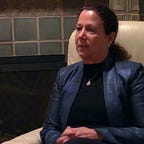Blind Spin
Since I am at the age where I may be labeled a “rising senior,” I have witnessed many cultural trends and fads over the years. The recent exercise trend, to personalize workouts and make them available in your home via specialized equipment and streaming over the internet seems to be a welcome development that is here to stay.
I am a fan of the Peloton workout; through the use of a stationary exercise bicycle, you can stream live or on demand spin classes right into your home. That means that at any hour of the day, you can choose from a huge variety of instructors, length and type of class. In addition, Peloton provides classes in strength training, running, yoga, amongst others, live or on demand for ultimate personal convenience. While the initial outlay for the bike is costly, the subscription price makes Peloton competitive with most athletic club memberships.
As an avid spin enthusiast for more than 25 years I was intrigued by the variety and convenience of these classes. I was impressed by the Peloton culture, with every instructor encouraging participants to do their best, vowing that no one would be left behind as the class worked together as a team, always emphasizing personal empowerment and inclusion.
So it was bitterly disappointing to me to discover that while Peloton has a huge following, including teachers who have achieved near cult status, despite the creation of a new market industry that should be available to all who can afford it in the luxury of their own homes, Peloton does not include me.
I am blind. Because the Peloton machine is operated using a touch screen that has no accessibility features for blind or low vision users, I can’t use it independently. I can’t turn the machine on, select my user screen, update or select a program without assistance from a third party. Unlike all other users, I cannot measure my output, respond to instructions from the class teachers to reach a certain level of intensity, cannot determine how much weight is on the wheel, because I can’t read the numbers that appear on the screen as metrics for elevation, speed and output. In other words, I have to ride ‘blind’, hoping that my riding to the rhythm of the music will approximate what the class is like for people who can see. The challenges posed by inaccessibility mean that I have no basis for measuring my success, or developing progress. The other programs, yoga, stretch, etc., are even more confounding as teachers use instructions like “put your hand here” or “place your foot there”, or at their worst, say things like “watch this.”
Rendering exercise equipment accessible in accordance with the ADA is not a novel idea. In fact, a committee made up of major exercise equipment manufacturers and a few people from the disability community have been working to develop standardized accessibility platforms for all exercise equipment, and a bill, H.R. 3929 — Greater Access and Independence through Nonvisual Access Technology of 2019 has been introduced and would create a, “minimum nonvisual access standard for home use medical devices, exercise equipment, and home appliances, and for other purposes.”
To date, none of the manufacturers of exercise equipment are responding to the disability community’s desire to be included in the pursuit of a healthy lifestyle. We are, once again, left in the dark.
If rendered accessible, the Peloton experience is extremely well suited to blind and low vision riders. Using the Peloton at home eliminates the time, cost and risk of getting to a class. The spin experience is as close as any blind person can come to reliving the joy of riding a bike outdoors! The ability to customize the workout means that blind or low vision riders can pursue physical fitness like everyone else. At a recent meeting of vision impaired professionals, I learned that there are literally hundreds of Peloton members who, like me, are vision impaired and use the system, despite the fact that we can experience only a fraction of what Peloton has to offer to sighted users.
So Peloton, let us blind spinners in! Your recent addition of captioning is a step in the right direction, but serves only the deaf and hard of hearing community. It is time to acknowledge that if you truly believe what your teachers preach, that we all should be included, you need to be sure that Peloton is made fully accessible to me, and millions like me. Spin us in, and let’s see just how much we can contribute to this growing industry which claims to represent the values of inclusion that are so critical for the 61 million Americans with disabilities, and more than a billion around the world.
